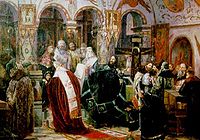- Macarios III Zaim
-
Macarios III Zaim Patriarch of Antioch Church Melkite Church See Patriarch of Antioch Enthroned 12 November 1647 Reign ended 12 June 1672 Predecessor Euthymius III of Chios Successor Neophytos of Chios Personal details Birth name John Zaim Born Aleppo Died 12 June 1672
DamascusPatriarch Yousef Yuhanna Meletios Macarios III Zaim (died 1672) was Melkite Greek Patriarch of Antioch from 1647 to 1672. He led a period of blossoming of his Church and he is also remembered for his travels in Russia and for his involvement in the reforms of Russian Patriarch Nikon.
Life
Yousef Zaim was born in Aleppo, son of the priest Paul and he was a disciple of Euthymius II Karmah. He was ordained priest (taking the name of Yuhanna) after the marriage and he also used to work as weaver. In 1627 Meletios Zaim had a son, Paul Zaim (sometime known as Paul of Aleppo), who became his secretary and biographer.[1]
After the death of his wife in 1627, he retired to the Mar Saba monastery until 1634. On October 27, 1635 he was consecrated metropolitan bishop of Aleppo by Patriarch Euthymius III of Chios (taking the name of Meletios), who also appointed him catholicos (supervisor) of the whole patriarchate. As Metropolian of Aleppo he led a bright and rich period for the Christians of Aleppo. In 1624 he led a pilgrimage to Jerusalem where he met the Catholicos of Georgia, whom he accompanied to Damascus. In 1647 he had to escape for a few time from Aleppo because of the persecutions of the governor.[2]
After the death of Patriarch Euthymios III, he went to Damascus where he was elected Patriarch and consecrated on November 12, 1647 by four metropolitans, under the name of Macarios III. His first aim was to restore the financial situation of the Patriarchate, which had deteriorated because of the excessive taxation of the Ottomans towards the Christians. In order to get financial help, he decided to start a long journey into the Eastern Europe countries. After having appointed and consecrated one vicar, on February 11, 1652 he took the road north, accompanied by his son Paul. He visited Constantinople, Wallachia (where he was well received by Prince Matei Basarab), Moldavia (where he met Prince Vasile Lupu), Ukraine and Tsardom of Russia.[2]
He was in Moscow from January 26, 1655 to May 29, 1656, as the guest of Tsar Alexis. During this visit he had a large part in the religious and liturgical reform of the Russian Patriarch Nikon, mainly because he brought with him the new recension of the Euchologion made by Euthymius II Karmah and other liturgical books of the Patriarchate of Antioch.[2]:83 Nikon's liturgical reform led to a major schism in the Russian Orthodox Church, the so called Raskol, or schism of the Old Believers.[3] Macarios Zaim also took a stand in favor the validity of the Catholic baptism of Poles, and his suggestion was approved.[1] Macarios nevertheless lamented over the atrocities committed by the Polish Catholics against followers of Greek Orthodoxy. Macarios took as example the religious peace that ruled in the Turkish empire, stating: God perpetuate the empire of the Turks for ever and ever! For they take their impost, and enter no account of religion, be their subjects Christians or Nazarenes, Jews or Samaritians; whereas these accursed Poles were not content with taxes and tithes from the brethren of Christ[4]
He was back in Damascus in 1659, where he succeeded in settling the debts of the patriarchate and excommunicated the Metropolitan of Homs, Athanasius Inb Amish, who acted as patriarch. In 1660 Macarios III blessed for the first time since 1594 the Holy Myron for all the patriarchate. Until 1661 he was quite reserved towards the Latin missionaries in Syria, but his attitude subsequently changed, and he wrote many times his greetings to the pope and maintained very good relations with the missionaries.[1] Macarios III secretly sent off a profession of the Catholic faith to Rome while publicly appearing to be in the Orthodox camp.[5]
In 1666 Patriach Macarios III left again for Moscow, invited by Tsar Alexis and accompanied by Patriarch Paisius of Alexandria, to pronounce the deposition of Patriarch Nikon. In Moscow, he asked the Polish king John Casimir to work for the union between the Eastern and Western Churches. He returned to Syria in 1672. He did not participate in the Synod of Jerusalem. He died, probably poisoned, in Damascus on June 12, 1672.[2]
Notes
- ^ a b c Skaff, Elias (1993). The place of the Patriarchs of Antioch in Church History. Sophia Press. pp. 296–301.
- ^ a b c d Raheb, Abdallah (1981). Nicholas J. Samra. ed. Conception of the Union in the Orthodox Patriarchate of Antioch (1622–1672). Beirut. pp. 79–96. http://www.zoukmikael.com/churches/stgeorge/biblio/CONCEPTION%20OF%20THE%20UNION.pdf. Retrieved 07/06/2010.
- ^ "A History of the Orthodox Church The Church of Russia (1448–1800)". http://www.orthodoxinfo.com/general/history5.aspx. Retrieved 13 July 2010.
- ^ The preaching of Islam: a history of the propagation of the Muslim faith By Sir Thomas Walker Arnold, pg. 134-135
- ^ Frazee, Charles A. (2006). Catholics and Sultans: The Church and the Ottoman Empire 1453–1923. Cambridge University Press. pp. 133. ISBN 9780521027007. http://books.google.com/books?id=X6DM4szwUpEC.
Categories:- 1672 deaths
- Patriarchs of Antioch
- People from Aleppo
Wikimedia Foundation. 2010.

